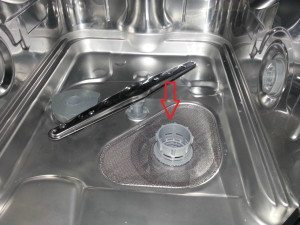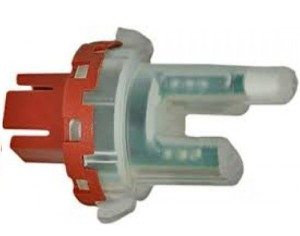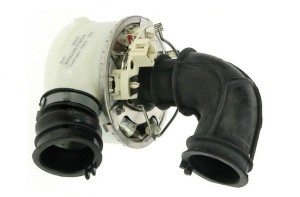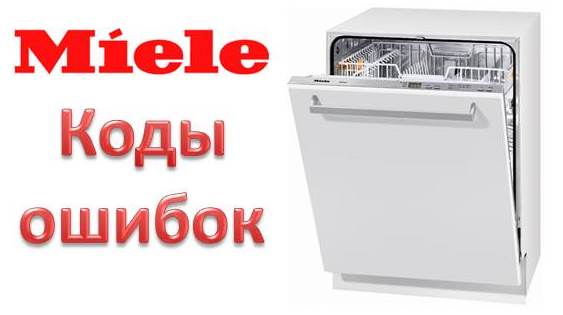The water in the dishwasher does not heat up
 Most dishwashers are connected only to a cold water supply system, so the operation of the heating element is very important, otherwise the dishes simply will not be washed. If the “dishwasher” does not heat the water, this will be noticeable immediately after the completion of the washing cycle, which means that the problem urgently needs to be fixed. It is not necessary that in this case we are talking about a malfunction of the heating element or temperature sensor; there are other reasons that we will need to talk about in the framework of this article.
Most dishwashers are connected only to a cold water supply system, so the operation of the heating element is very important, otherwise the dishes simply will not be washed. If the “dishwasher” does not heat the water, this will be noticeable immediately after the completion of the washing cycle, which means that the problem urgently needs to be fixed. It is not necessary that in this case we are talking about a malfunction of the heating element or temperature sensor; there are other reasons that we will need to talk about in the framework of this article.
Why does the water in the dishwasher remain cold?
Why doesn't the dishwasher heat the water? To answer this question, it is necessary to approach the solution of the problem systematically, namely, to consider the interconnections of all units and sensors of the dishwasher and decide what can (at least indirectly) negatively affect the operation of the heating element? There are three main reasons why the water in the dishwasher remains cold:
- the heating element itself is faulty;
- The thermostat is faulty;
- control unit element is faulty.
In addition to the main reasons why the water in the car does not heat up, there are additional ones. At first glance, it seems that these breakdowns cannot have any effect on the thermoelements at all, but this is actually not the case. Let's look at additional reasons why the water in the dishwasher tank is not heating up.
- The dishwasher is not connected according to the instructions.

- There is a severe blockage in the garbage filter.
- User error when selecting a washing mode.
- The pressure sensor is faulty.
The pressure sensor helps control the water circulation in the dishwasher. If the pressure sensor is faulty, then water can constantly circulate in the dishwasher, which in turn can cause it to drain itself. Under these conditions, even if the heating element is in working condition, it simply does not have time to heat the water and the “dishwasher” is forced to use cold water to carry out the washing program. The problem is solved by replacing the pressure sensor; repair in this case is useless.
For your information! Before replacing the pressure sensor, you can try cleaning its contacts, and also inspect the electrical wiring that powers the sensor.
 If your dishwasher stops heating water, the reason may be a clogged garbage filter. Some people will ask, what does a garbage filter have to do with it and what does it have to do with the heating element? We will answer - the most direct.
If your dishwasher stops heating water, the reason may be a clogged garbage filter. Some people will ask, what does a garbage filter have to do with it and what does it have to do with the heating element? We will answer - the most direct.
The fact is that when carrying out a washing program, water must circulate normally between the tank and special reservoirs; accordingly, the heating element maintains the water temperature, ensuring normal quality of dishwashing. And if the filter is clogged, the circulation is disrupted. This leads to the accumulation of water in the tank, the system will be forced to replenish water (which does not return back from the tank with dishes to the tank) from the water supply, and it is, accordingly, cold - the heating element simply will not have time to heat it.
To identify this problem, you need to look into the tank while washing. Under normal conditions, water should not linger there. If water accumulates in the tank, then you need to urgently clean the garbage filter. After this, water circulation will resume, and you can count on eliminating problems with water heating, unless, of course, a simultaneous breakdown of the thermistor or heating element has occurred, and this is also quite possible.
If the water does not heat up in a new dishwasher, then in this case the problem may be that it was not connected to the sewer correctly. What's the matter here? When connecting the dishwasher drain hose correctly to the sewer pipe, the technician makes two elbows (smooth bends of the hose): one at the very base of the “dishwasher”, and the other at the place where the hose is connected to the siphon.
Important! These two elbows are needed to prevent a “siphon effect” from occurring, that is, water does not flow from the sewer pipe back into the dishwasher.
Accordingly, if normal drainage of water into the sewer is impossible, then the water in the “dishwasher” will also not be able to circulate. This will lead to the water temperature being different from the one set by the program, and this is in the best case. At worst, the water will remain cold, and the user will “sin” the heating element, although it has absolutely nothing to do with it. The problem can be solved simply - the connection to the sewer is done according to the instructions, and the machine starts working normally.
Sometimes a Bosch dishwasher (or another brand) does not heat the water for a very prosaic reason - the user has selected the wrong washing program. This happens rarely, since modern “dishwashers” do not have so many programs to get confused in them, but it still happens. Recipe - read the instructions and learn how to select the right washing program for the specific volume and category of dishes being loaded.
Checking and repairing the temperature sensor, control module
Now let's move on to consider the main reasons why the dishwasher does not heat the water. Let's start with the temperature sensor. For some reason, this element has become a kind of weak point in dishwashers of most brands, including Bosch.Therefore, first, let's decide how to understand that the temperature sensor is really broken, and not something else, and it is this that needs to be replaced? We act like this.
- Take screwdrivers, pliers and a multimeter.
- We disconnect the dishwasher from the water supply, sewerage and electrical networks (do not forget to turn off the water at the pipe outlet).
- We take out the baskets for dishes from the Bosch dishwasher tank.
- We take out the lower sprinkler, take out the garbage filter, remove the mesh and unscrew the two fasteners located under it.
- Turn the dishwasher upside down and unscrew the plastic (or metal) side fastenings.
- We disconnect the drain pipe from the plastic block with the heating element and lift the bottom of the dishwasher up.
- The sensor is located in the body of the heating block, this is necessary so that the water temperature is accurately monitored by the control module. Disconnect the wires from the contacts of the temperature sensor.
- We clean the contacts and measure the resistance of the temperature sensor.
- We take out the burnt temperature sensor, replace it with a new similar one, and then assemble the “dishwasher”.
Important! In this case, the problem does not always lie in the temperature sensor; sometimes the wiring is faulty, and in rare cases even the control module element.
In about 1% of cases, it happens that the heating element is working, the temperature sensor is also working and the wires are in order. Moreover, they have already checked the machine for blockages, and checked whether it is installed correctly, checked the pressure sensor - everything works fine, and the temperature of the water in the cold water supply pipe and the temperature in the dishwasher still remain the same.There is a possibility that the control module in your “dishwasher” has broken down, namely not the entire module, but one of its triacs.
For our part, we categorically do not recommend climbing into the control module yourself without having the skills to work with electronics. There is a high risk of damaging it even more, and buying a replacement part will be very expensive. Seek help from a specialist.
How to check and replace the heating element?
 If the reason that the water in the dishwasher does not heat up is a burnt heating element, you need to prepare for expensive repairs, but first you need to make sure that the cause of the breakdown is indeed a heating element. The problem is that the dishwasher heating element Bosch in some cases is a flow-through type and if something happens, it must be replaced with a module, which makes repairs more expensive. Check and replacing heating element in dishwasher must be carried out in a strictly defined order. Read about how this is done in the article of the same name on our website.
If the reason that the water in the dishwasher does not heat up is a burnt heating element, you need to prepare for expensive repairs, but first you need to make sure that the cause of the breakdown is indeed a heating element. The problem is that the dishwasher heating element Bosch in some cases is a flow-through type and if something happens, it must be replaced with a module, which makes repairs more expensive. Check and replacing heating element in dishwasher must be carried out in a strictly defined order. Read about how this is done in the article of the same name on our website.
In conclusion, we note that if the water does not heat up in the dishwasher, then this is not a reason to panic. First, you need to limit the range of possible faults that led to this result, and only then begin a systematic search for the problem point. Good luck with the renovation!
Interesting:
4 reader comments
Add a comment Cancel reply
Categories
Washing machine repair


For buyers

For users

Dishwasher

















PMM Veko 3801. Didn’t heat the water or dry it.
I cleaned the contacts on the temperature sensor and everything worked.
Thank you for the article!
I also cleaned and tightened the contacts on the temperature sensor and everything worked. AEG Favorit F43070IM.
Thank you very much for the article! Everything turned out to be simple - the beans clogged the drain hole.
Can you please tell me where the temperature sensor is located?